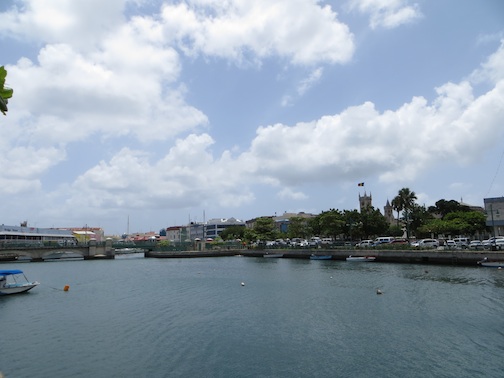Above: Barbados, home to the CDB, is current on its obligations to the bank (CJ Photo)
By the Caribbean Journal staff
Standard & Poor’s has lowered the long-term foreign currency credit rating on the Caribbean Development Bank to “AA” from “AA+” citing its revised criteria for multilateral lending institutions, the New York-based ratings firm announced Wednesday.
The firm also lowered the bank’s outlook to negative.
The bank’s outlook was previously “stable” when S&P downgraded the bank’s long-term issuer credit rating to “AA+” from “AAA” in June.
S&P praised the bank’s “strong business profile,” which it said was “anchored by its role as a prominent lender to Caribbean governments and its historical capacity to lend countercyclically through the credit cycle in support of its public policy mandate,” according to Standard & Poor’s credit analyst Kelli Bissett.
Bissett also said period capital increases, the most recent of which was planned to increase CDB’s paid-in capital by 138 percent over six years “have demonstrated shareholder support.” Most major and extraregional shareholders have begun to pay in their subscriptions on time, she said, although 28 percent of anticipated payments for the first two years are pending due to administrative and parliamentary delays.
“CDB’s strong business profile has elements that are weaker than those of higher-rated peers,” she said. “Although most borrowing members traditionally have treated CDB as a preferred creditor, one government borrower is more than 180 days in arrears to CDB on interest and principal, while the government has paid its commercial debt.”
The firm did not mention the country by name.
The CDB has halted disbursements to this borrower in arrears, she said, and a late interest penalty is accruing on the arrears.
But the firm said preferred creditor treatment was an “important element” in its assessment, because it “speaks to the CDB’s membership support, capital adequacy and our expectation of loss given default.”
“CDB’s exposure to this government borrower more than 180 days past due is 3 percent of its loans and 5 percent of adjusted common equity (net of receivables from members)” she said.
S&P said CDB’s capitalization was the “cornerstone of its very strong financial profile.”
But the firm has adopted what is calls a risk-adjusted capital framework to analyze the capital adequacy of multilateral lending institutions. And under this framework, the risk-adjusted capital ratio falls to 21 percent, which the firm said was higher than that of any other MLIs, though “appropriate given CDB’s operational risks.”
The CDB’s largest loan exposures are to Jamaica (24 percent of loans), Barbados (12 percent), St Vincent and the Grenadines (10 percent), St Lucia (9 percent) and Belize (7 percent).
All of those five borrowers remain current on their obligations to the bank.
The bank affirmed its “A-1+” short-term foreign currency rating on the bank.
“The negative outlook reflects embedded credit risks in CDB’s loan portfolio,” Bissett said. “Our view of the treatment of CDB as a preferred creditor by its borrowing member shareholders, which is established by practice, is a pivotal component of this analysis.”
Bissett said the firm could lower its ratings if other member governments fall more than 180 days past due, or if the bank’s funding conditions weakened.
The ratings “could stabilize at current levels if the public-sector loan performance improves and if member capital contributions comply with scheduled payments,” she said.
